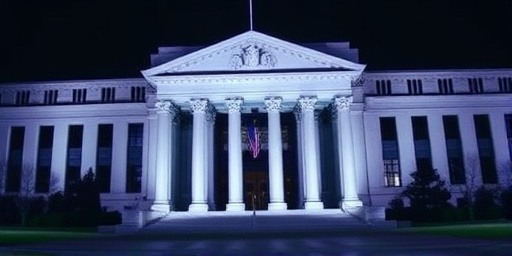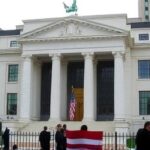U.S. stock futures tumbled sharply in pre-market trading on Monday, signaling a rocky start to the week for global markets, as Federal Reserve officials delivered conflicting messages on the timing and necessity of interest rate cuts. The discord among policymakers has injected fresh uncertainty into an already volatile economy, with investors grappling to interpret the mixed signals from the world’s most influential central bank.
The Dow Jones Industrial Average futures dropped 0.8%, or about 320 points, while S&P 500 futures slid 0.9% and Nasdaq futures fell 1.1%. This downturn comes on the heels of a weekend where Fed speakers, including influential voices from regional branches, publicly diverged on the path forward for monetary policy. With inflation still lingering above the Fed’s 2% target and the labor market showing signs of cooling, the debate over rate cuts has become a flashpoint for market sentiment.
Fed Hawks and Doves Clash on Rate Cut Timeline
The rift within the Federal Reserve became starkly apparent during a series of speeches and interviews over the past 48 hours. Atlanta Federal Reserve President Raphael Bostic, a known hawk, reiterated his stance that premature rate cuts could reignite inflationary pressures, stating in a CNBC interview, “We need to see sustained evidence of cooling before easing policy—rushing now risks undoing our progress.” Bostic’s comments contrasted sharply with those from San Francisco Fed President Mary Daly, who advocated for a more dovish approach, noting in a Bloomberg op-ed that “with unemployment ticking up to 4.1% in recent data, the case for rate cuts to support the economy is strengthening.”
This internal disagreement echoes the broader tensions at the Fed’s July meeting, where minutes revealed a 7-2 vote to hold rates steady at 5.25-5.50%, but with growing calls for cuts by September. Chair Jerome Powell, in his Jackson Hole symposium remarks last month, had hinted at potential easing if data warranted, but his recent silence amid the hawk-dove divide has only amplified market jitters. Analysts point to the Personal Consumption Expenditures (PCE) index, which rose 2.5% year-over-year in July, as a key factor fueling the debate—close enough to the target to tempt doves, yet persistent enough to caution hawks.
Historical context underscores the stakes: The last time Fed officials publicly split so visibly was during the 2019 trade war era, leading to a 1,000-point Dow swing in a single day. Today’s stock futures reaction suggests investors fear a similar whipsaw effect, with rate cut expectations now priced in at just 85% probability for September, down from 95% a week ago, according to CME FedWatch Tool data.
Stock Futures Lead the Charge in Market Sell-Off
As news of the Fed’s discord spread, stock futures across major indices plunged, dragging global markets into the red. European benchmarks like the FTSE 100 and DAX opened down 0.6% and 0.7%, respectively, while Asian markets closed lower, with Japan’s Nikkei 225 shedding 1.2% amid yen strength concerns tied to U.S. policy uncertainty. The ripple effects were felt in commodity markets too, with oil prices dipping below $80 per barrel as rate cut delays could crimp economic growth and demand.
In the U.S., technology stocks bore the brunt, with futures for Apple and Nvidia—key drivers of the S&P 500—falling over 1.5%. This sector sensitivity stems from high borrowing costs squeezing growth stocks’ valuations, where every basis point in rates matters. Broader market data from Friday’s close showed the S&P 500 at 5,460, down 0.3% for the week, but Monday’s pre-market signals point to a deeper correction if Fed rhetoric hardens.
Trading volume in futures markets spiked 25% above average, indicating heightened investor anxiety. Hedge funds and institutional players, who control over 70% of futures contracts, appear to be unwinding leveraged positions built on rate cut bets. A report from JPMorgan estimated that a delay in cuts could trigger $500 billion in portfolio reallocations, shifting funds from equities to safer assets like Treasury bonds, which saw yields on the 10-year note climb to 4.15% in after-hours trading.
- Dow Futures: -0.8% (320 points)
- S&P 500 Futures: -0.9%
- Nasdaq Futures: -1.1%
- Global Impact: FTSE 100 -0.6%, Nikkei 225 -1.2%
The futures market’s role as a barometer for investor mood cannot be overstated; it often foreshadows cash market opens, and with the New York session looming, traders are bracing for volatility. Options activity surged, with put-call ratios hitting 1.2, a level associated with bearish sentiment in 80% of historical instances, per Bloomberg data.
Economic Data Fuels Uncertainty in Fed’s Rate Cut Debate
Underpinning the Federal Reserve’s internal squabble is a mosaic of economic indicators painting a picture of moderation but not deceleration. July’s nonfarm payrolls added 114,000 jobs, below expectations of 175,000, signaling a softening labor market that doves like Daly cite as justification for rate cuts. Yet, wage growth held steady at 3.6% annually, giving hawks ammunition to argue that inflationary risks persist in the services sector, which accounts for 70% of U.S. GDP.
The economy’s resilience is evident in consumer spending, which rose 0.8% in Q2, buoyed by savings rates dipping to 3.6%—a level that suggests households are dipping into reserves to maintain lifestyles amid high rates. Retail sales data from last week showed a 1% uptick in durable goods, but auto sales lagged due to elevated financing costs, highlighting how the Fed’s policy directly impacts everyday economic activity.
Inflation metrics remain the linchpin. Core CPI, excluding food and energy, eased to 3.2% in July, but shelter costs—up 5.2%—continue to exert upward pressure. Fed models project that without rate cuts, GDP growth could slow to 1.8% in 2024 from 2.5% this year, potentially tipping the economy toward recession if consumer confidence erodes further. A University of Michigan survey pegged sentiment at 70.2 in August, down from 71.6, with inflation expectations steady at 2.9%.
Internationally, the Fed’s decisions reverberate. The European Central Bank cut rates last week, citing similar pressures, but ECB President Christine Lagarde warned that U.S. policy divergence could strengthen the dollar, hurting Eurozone exports. Emerging markets, from Brazil to India, face capital outflows as higher U.S. rates attract flight-to-safety flows, exacerbating their own economic challenges.
Wall Street Experts Parse Fed’s Mixed Signals
Market veterans wasted no time dissecting the Federal Reserve’s latest pronouncements. Goldman Sachs chief economist Jan Hatzius, in a client note, described the split as “a classic hawk-dove standoff that could delay cuts by one meeting,” predicting a 25-basis-point reduction in December rather than September. Hatzius highlighted that FOMC projections from June showed a median expectation of two cuts this year, but dissenting votes suggest that number could shrink.
Conversely, BlackRock’s Rick Rieder urged caution, telling Reuters, “The economy is walking a tightrope—rate cuts too soon, and inflation roars back; too late, and growth stalls. Investors should diversify beyond stocks into inflation-protected securities.” This view aligns with a Morningstar survey where 62% of fund managers expect prolonged higher rates, prompting a 15% allocation shift to bonds in Q3 portfolios.
Smaller institutions echoed the unease. A Piper Sandler report noted that regional bank stocks, sensitive to rate environments, fell 2% in pre-market, as net interest margins—already compressed by 50 basis points since 2023—face further strain without cuts. Tech analysts at Wedbush Securities warned of a “rotation trade,” where money flows from overvalued megacaps to value stocks in energy and financials, potentially reshaping market leadership.
Retail investors, via platforms like Robinhood, showed panic selling in after-hours, with ETF outflows reaching $2 billion last week. Social media buzz on X (formerly Twitter) trended with #FedWatch, where users debated outcomes, amplifying the psychological impact on markets. Behavioral economists note that such public Fed spats erode trust, leading to herd behavior and amplified volatility.
- Monitor upcoming CPI release on September 11 for fresh inflation clues.
- Watch FOMC minutes from the July meeting, due Wednesday, for hints of consensus shifts.
- Track labor data, including next Friday’s jobs report, which could sway undecided officials.
Outlook: Navigating Rate Cut Delays and Economic Headwinds
Looking ahead, the Federal Reserve’s path will hinge on incoming data, but the current disagreement portends choppy waters for markets and the economy. If hawks prevail, prolonged higher rates could temper inflation but risk a hard landing, with recession odds climbing to 35% per New York Fed models. Doves, if vindicated by softer data, might accelerate cuts, boosting stock futures and easing borrowing for businesses and consumers.
Investors are advised to eye the September FOMC meeting closely, where dot plots could clarify the trajectory. In the interim, defensive strategies—like increasing cash holdings to 10-15% of portfolios, as recommended by Vanguard—may mitigate downside. Globally, coordinated policy from the Fed could stabilize markets, but unilateral hawkishness risks widening yield spreads and currency volatility.
For the broader economy, the stakes are high: Rate cuts are pivotal for sustaining the post-pandemic recovery, supporting housing starts (down 5% YoY) and business investment (flat at 2.1% growth). Small businesses, per NFIB surveys, report 40% citing high rates as their top concern, potentially curbing hiring and expansion. As the debate rages, markets remain on edge, with stock futures poised to set the tone for a pivotal week in monetary policy discourse.









